Discovered 13 February 1974 | ||
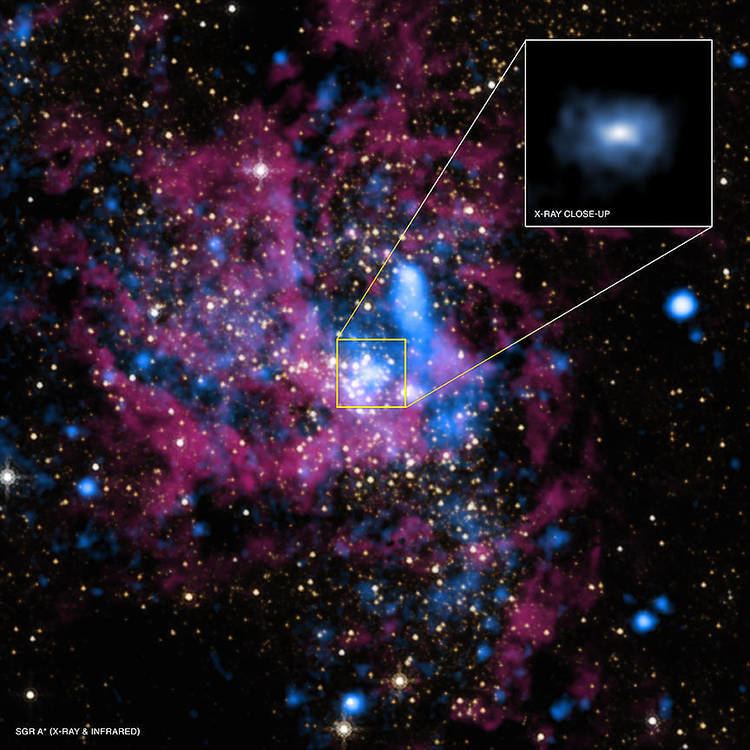 | ||
Similar | ||
Sagittarius A* (pronounced "Sagittarius A-star", standard abbreviation Sgr A*) is a bright and very compact astronomical radio source at the center of the Milky Way, near the border of the constellations Sagittarius and Scorpius. It is part of a larger astronomical feature known as Sagittarius A. Sagittarius A* is thought to be the location of a supermassive black hole, like those that are now generally accepted to be at the centers of most spiral and elliptical galaxies. Observations of the star S2 in orbit around Sagittarius A* have been used to show the presence of, and produce data about, the Milky Way's central supermassive black hole, and have led to the conclusion that Sagittarius A* is the site of that black hole.
Contents
- Tour of sagittarius a
- Observation and description
- History
- Central black hole
- Discovery of G2 gas cloud on an accretion course
- References
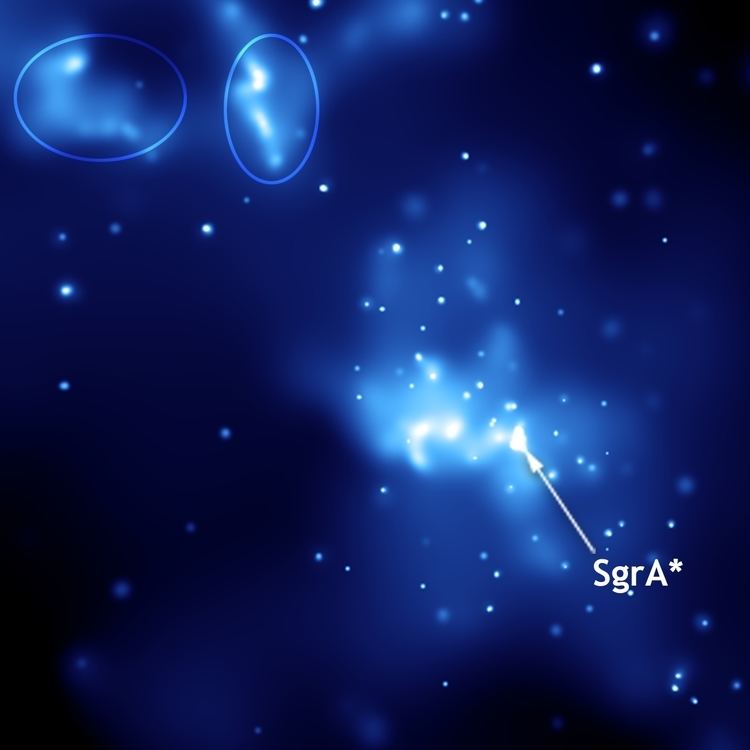
Tour of sagittarius a
Observation and description
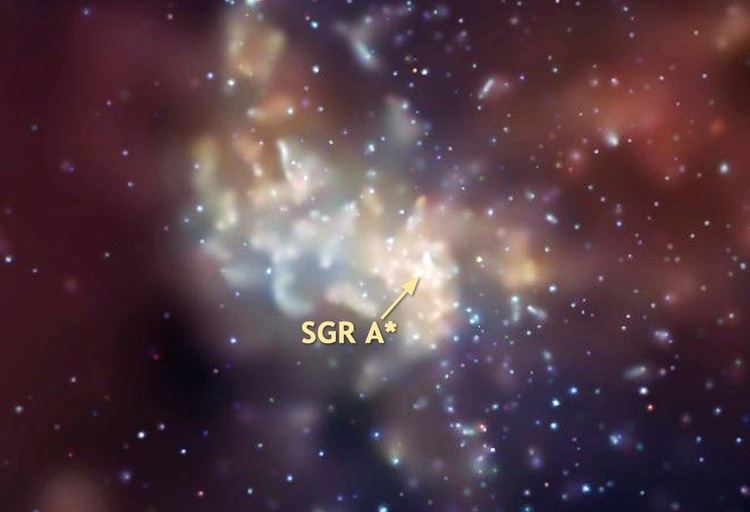
Astronomers have been unable to observe Sgr A* in the optical spectrum because of the effect of 25 magnitudes of extinction by dust and gas between the source and Earth. Several teams of researchers have attempted to image Sagittarius A* in the radio spectrum using very-long-baseline interferometry (VLBI). The current highest-resolution measurement, made at a wavelength of 1.3 mm, indicated an angular diameter for the source of 37 μas. At a distance of 26,000 light-years, this yields a diameter of 44 million kilometers. For comparison, Earth is 150 million kilometers from the Sun, and Mercury is 46 million kilometers from the Sun at perihelion. The proper motion of Sgr A* is approximately −2.70 mas per year for the right ascension and −5.6 mas per year for the declination.
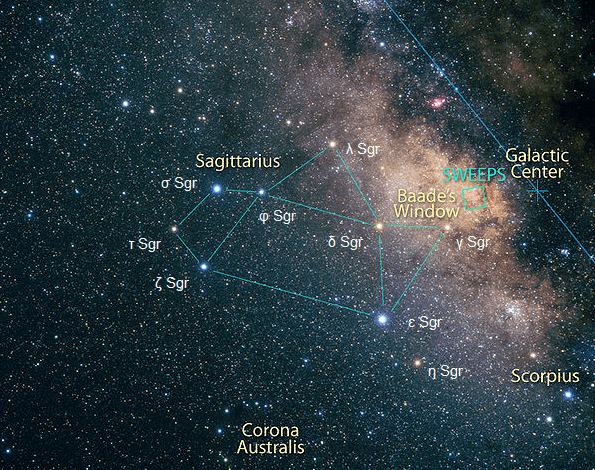
There are plans to image Sagittarius A* in much greater detail than before using interferometry combining images from widely spaced observatories at different places on Earth. It is hoped the measurements will test Einstein's theory of relativity more rigorously than has previously been done. Discrepancies may be found between the theory and actual observation or, if there are no discrepancies relativity may be confirmed.
History
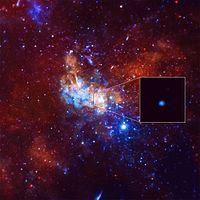
Karl Jansky was the first person to determine that a radio signal was coming from a location at the center of the Milky Way, in the direction of the constellation of Sagittarius. Sgr A* was discovered on February 13 and 15, 1974, by astronomers Bruce Balick and Robert Brown using the baseline interferometer of the National Radio Astronomy Observatory. The name Sgr A* was coined by Brown in a 1982 paper because the radio source was "exciting", and excited states of atoms are denoted with asterisks.

On October 16, 2002, an international team led by Rainer Schödel of the Max Planck Institute for Extraterrestrial Physics reported the observation of the motion of the star S2 near Sagittarius A* over a period of ten years. According to the team's analysis, the data ruled out the possibility that Sgr A* contains a cluster of dark stellar objects or a mass of degenerate fermions, strengthening the evidence for a massive black hole. The observations of S2 used near-infra red (NIR) interferometry (in the K-band, i.e. 2.2 μm) because of reduced interstellar extinction in this band. SiO masers were used to align NIR images with radio observations, as they can be observed in both NIR and radio bands. The rapid motion of S2 (and other nearby stars) easily stood out against slower-moving stars along the line-of-sight so these could be subtracted from the images.
The VLBI radio observations of Sagittarius A* could also be aligned centrally with the images so S2 could be seen to orbit Sagittarius A*. From examining the Keplerian orbit of S2, they determined the mass of Sagittarius A* to be 2.6 ± 0.2 million solar masses, confined in a volume with a radius no more than 17 light-hours (120 AU). Later observations of the star S14 showed the mass of the object to be about 4.1 million solar masses within a volume with radius no larger than 6.25 light-hours (45 AU) or about 6.7 billion kilometres. They also determined the distance from Earth to the Galactic Center (the rotational center of the Milky Way), which is important in calibrating astronomical distance scales, as 8.0 ± 0.6 × 103 parsecs. In November 2004 a team of astronomers reported the discovery of a potential intermediate-mass black hole, referred to as GCIRS 13E, orbiting three light-years from Sagittarius A*. This black hole of 1,300 solar masses is within a cluster of seven stars. This observation may add support to the idea that supermassive black holes grow by absorbing nearby smaller black holes and stars.
After monitoring stellar orbits around Sagittarius A* for 16 years, Gillessen et al. estimate the object's mass at 4.31 ± 0.38 million solar masses. The result was announced in 2008 and published in The Astrophysical Journal in 2009. Reinhard Genzel, team leader of the research, said the study has delivered "what is now considered to be the best empirical evidence that super-massive black holes do really exist. The stellar orbits in the Galactic Center show that the central mass concentration of four million solar masses must be a black hole, beyond any reasonable doubt."
On January 5, 2015, NASA reported observing an X-ray flare 400 times brighter than usual, a record-breaker, from Sgr A*. The unusual event may have been caused by the breaking apart of an asteroid falling into the black hole or by the entanglement of magnetic field lines within gas flowing into Sgr A*, according to astronomers.
Central black hole
If the apparent position of Sagittarius A* were exactly centered on the black hole, it would be possible to see it magnified beyond its actual size, because of gravitational lensing. According to general relativity, this would result in a minimum observed size of at least 5.2 times the black hole's Schwarzschild radius, which, for a black hole of around 4 million solar masses, corresponds to a minimum observed size of approximately 52 μas. This is much larger than the observed size of 37 μas and so suggests that the Sagittarius A* radio emissions are not centered on the hole but arise from a bright spot in the region around the black hole, close to the event horizon, possibly in the accretion disc or a relativistic jet of material ejected from the disc.
The mass of Sagittarius A* has been estimated in two different ways.
- Two groups—in Germany and the U.S.—monitored the orbits of individual stars very near to the black hole and used Kepler's laws to infer the enclosed mass. The German group found a mass of 4.31 ± 0.38 million solar masses, whereas the American group found 3.7 ± 0.2 million solar masses. Given that this mass is confined inside a 44 million km diameter sphere, this yields a density ten times higher than previous estimates.
- More recently, measurement of the proper motions of a sample of several thousand stars within approximately one parsec from the black hole, combined with a statistical technique, has yielded both an estimate of the black hole's mass at 7006360000000000000♠3.6+0.2
−0.4×106 M☉, plus a distributed mass in the central parsec amounting to 7006100000000000000♠(1±0.5)×106 M☉. The latter is thought to be composed of stars and stellar remnants.
Astronomers are confident that these observations of Sagittarius A* provide good empirical evidence that the Milky Way has a supermassive black hole at its center, 26,000 light-years from the Solar System because:
Although strictly speaking there are other mass configurations that would explain the measured mass and size, such an arrangement would collapse into a single supermassive black hole on a timescale much shorter than the age of the Milky Way.
The comparatively small mass of this black hole, along with the low luminosity of the radio and infrared emission lines, imply that the Milky Way is not a Seyfert galaxy.
Ultimately, what is seen is not the black hole itself, but observations that are consistent only if there is a black hole present near Sgr A*. In the case of such a black hole, the observed radio and infrared energy emanates from gas and dust heated to millions of degrees while falling into the black hole. Although other possibilities exist for how these gases emanate energy, such as radiation pressure and interaction with other gas streams, interaction with a massive source of gravity is the simplest explanation. The black hole itself is thought to emit only Hawking radiation at a negligible temperature, on the order of 10−14 kelvin.
The European Space Agency's gamma-ray observatory INTEGRAL has observed gamma rays interacting with the nearby giant molecular cloud Sagittarius B2, causing X-ray emission from the cloud. This energy was emitted about 350 years earlier by Sgr A*, possibly detectable from Earth around the year 1650. The total luminosity from this outburst (L≈1,5×1039 erg/s) is estimated to be a million times stronger than the current output from Sgr A* and is comparable with a typical active galactic nucleus. In 2011 this conclusion was supported by Japanese astronomers observing the Milky Way's center with the Suzaku satellite.
Discovery of G2 gas cloud on an accretion course
First noticed as something unusual in images of the center of the Milky Way in 2002, the gas cloud G2, which has a mass about three times that of Earth, was confirmed to be likely on a course taking it into the accretion zone of Sgr A* in a paper published in Nature in 2012. Predictions of its orbit suggested it would make its closest approach to the black hole (a perinigricon) in early 2014, when the cloud was at a distance of just over 3000 times the radius of the event horizon (or ≈260 AU, 36 light-hours) from the black hole. G2 has been observed to be disrupting since 2009, and was predicted by some to be completely destroyed by the encounter, which could have led to a significant brightening of X-ray and other emission from the black hole. Other astronomers suggested the gas cloud could be hiding a dim star, or a binary star merger product, which would hold it together against the tidal forces of Sgr A*, allowing the ensemble to pass by without any effect. In addition to the tidal effects on the cloud itself, it was proposed in May 2013 that, prior to its perinigricon, G2 might experience multiple close encounters with members of the black-hole and neutron-star populations thought to orbit near the Galactic Center, offering some insight into the region surrounding the supermassive black hole at the center of the Milky Way.
The average rate of accretion onto Sgr A* is unusually small for a black hole of its mass and is only detectable because it is so close to Earth. It was thought that the passage of G2 in 2013 might offer astronomers the chance to learn much more about how material accretes onto supermassive black holes. Several astronomical facilities observed this closest approach, with observations confirmed with Chandra, XMM, EVLA, INTEGRAL, Swift, Fermi and requested at VLT and Keck.
Simulations of the passage were made before it happened by groups at ESO and Lawrence Livermore National Laboratory (LLNL).
As the cloud approached the black hole, Dr. Daryl Haggard said "It's exciting to have something that feels more like an experiment", and hoped that the interaction would produce effects that would provide new information and insights.
Nothing was observed during and after the closest approach of the cloud to the black hole, which was described as a lack of "fireworks" and a "flop". Astronomers from the UCLA Galactic Center Group published observations obtained on March 19 and 20, 2014, concluding that G2 was still intact (in contrast to predictions for a simple gas cloud hypothesis) and that the cloud was likely to have a central star.
An analysis published on 21 July 2014 based on observations by the ESO’s Very Large Telescope in Chile concluded alternatively that the cloud, rather than being isolated, might be a dense clump within a continuous but thinner stream of matter, and would act as a constant breeze on the disk of matter orbiting the black hole, rather than sudden gusts that would have caused fireworks as they hit, as originally expected. Supporting this hypothesis, G1, a cloud that passed near the black hole 13 years ago, had an orbit almost identical to G2, consistent with both clouds, and a gas tail thought to be trailing G2, all being denser clumps within a large single gas stream.
Professor Andrea Ghez et al. suggested in 2014 that G2 is not a gas cloud but rather a pair of binary stars that had been orbiting the black hole in tandem and merged into an extremely large star.
Sgr A* is monitored on a daily basis by the X-ray telescope of the Swift satellite.
